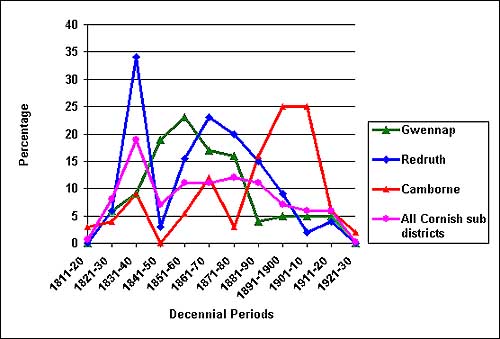|
Home > The Cornish in Latin America > Maps and Graphs > Decennial migration from top 4 sub-districts |
|
None of these sub-registration districts comprising parishes only a few miles apart, has the same decennial migration patterns. Redruth and Camborne are at opposite ends of the spectrum as regards the timing of migration to Latin America, the former peaking relatively early, the latter much later, while Gwennap falls somewhere between the two. The question is, why? Redruth was the undisputed commercial and trading centre of a vast mining district and housed a large mining population while Gwennap’s mining villages were still developing in the 1830s and 40s, and while Camborne town was little more than a large village. In the early nineteenth century Redruth was a dynamic thrusting industrial settlement at the very heart of Cornish mining and it is here that the major recruiting for labour by British backed Latin American mining companies took place. The sharp decline in figures in the 1830s is largely due to the fall in numbers of people migrating to Cuba due to fear of contracting yellow fever that was then endemic at Cobre. Redruth’s fortunes as an industrial centre waned with the decline of the copper mines from the mid nineteenth century and this is reflected in its migration figures to Latin America that fall gradually in the decades following the collapse of the Cornish copper mining industry. The period after 1871 sees migration flows from Camborne rise sharply to reach their acme in the two decades 1891-1910. Paradoxically, this came at a time when overall migration figures from Cornwall to Latin America were falling. However, by the late nineteenth century Camborne had become Cornwall’s premier mining and engineering centre, eclipsing Redruth that had reinvented itself in the 1880s as a residential and commercial/financial centre. With a few exceptions, mining had all but contracted to a nucleus of activity Camborne that was attracting mining labour from across the county. This labour was in turn being recruited for overseas concerns making use of formal and informal migration networks that had been in place for decades. Patterns from Gwennap are more stable than those from Camborne and Redruth, showing a gradual rise throughout the early nineteenth century to a high point in the decade 1851-61. Thereafter they begin to fall as the copper mining industry in the region begins to contract. Apart from a brief reprieve in the period before World War One, figures to Latin America from Gwennap fall from the mid nineteenth century. What the data does not depict is the regions in Latin America that were attracting labour from the three sub districts in each decennial period. In order for such an analysis to be undertaken it would be necessary to obtain more quantitative data as the numbers are currently too few to be reliable. But broad trends are discernible; Cuba is attracting the majority of migrants from Redruth in the 1830s and Camborne migration in the two decades after 1891 is largely accounted for by flows to Mexico. Gwennap is attracting much labour to the Pacific Littoral in the 1850s at the time when several Cornish mining magnates were running successful enterprises in Chile and Bolivia. Interestingly, it appears that migration to Latin America was at its height in all three sub-registration districts when mining within them was at its zenith, casting considerable doubt on the hypothesis which concludes that most migration occurs in times of economic stress. |
